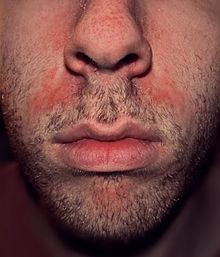
Back التهاب الجلد الدهني Arabic Себарэя Byelorussian Себорея Bulgarian ঘর্মমেদীয় চর্মপ্রদাহ Bengali/Bangla Dermatitis seborreica Catalan Seboroická dermatitida Czech Seborrhoisches Ekzem German Dermatitis seborreica Spanish Dermatitis seborreiko Basque درماتیت سبورهای Persian
| Seborrhoeic dermatitis | |
|---|---|
| Other names | Sebopsoriasis, seborrhoeic eczema, pityriasis capitis[1] |
 | |
| Seborrhoeic dermatitis of the face | |
| Specialty | Dermatology |
| Symptoms | Flaking, dry or greasy, red, itchy, and inflamed skin[2][3] |
| Duration | Several weeks to lifelong [4] |
| Causes | Multiple factors[4] |
| Risk factors | Stress, dry skin, winter, poor immune function, Parkinson disease[4] |
| Diagnostic method | Based on symptoms[4] |
| Differential diagnosis | Psoriasis, atopic dermatitis, tinea capitis, rosacea, systemic lupus erythematosus[4] |
| Treatment | Humidifier |
| Medication | Antifungal cream, anti-inflammatory agents, coal tar, phototherapy[3] |
| Frequency | ~5% (adults),[4] ~10% (babies)[5] |

Seborrhoeic dermatitis (also spelled seborrheic dermatitis in American English) is a long-term skin disorder.[4] Symptoms include flaky, scaly, greasy, and occasionally itchy and inflamed skin.[2][3] Areas of the skin rich in oil-producing glands are often affected including the scalp, face, and chest.[4] It can result in social or self-esteem problems.[4] In babies, when the scalp is primarily involved, it is called cradle cap.[2] Seborrhoeic dermatitis of the scalp may be described in lay terms as dandruff due to the dry, flaky character of the skin.[6] However, as dandruff may refer to any dryness or scaling of the scalp, not all dandruff is seborrhoeic dermatitis.[6] Seborrhoeic dermatitis is sometimes inaccurately referred to as seborrhoea.[4]
The cause is unclear but believed to involve a number of genetic and environmental factors.[2][4] Risk factors for seborrhoeic dermatitis include poor immune function, Parkinson's disease, and alcoholic pancreatitis.[4][6] The condition may worsen with stress or during the winter.[4] Malassezia yeast is believed to play a role.[6] It is not a result of poor hygiene.[7] Diagnosis is typically clinical and based on the symptoms present.[4][8] The condition is not contagious.[9]
The typical treatment is topical antifungal cream and anti-inflammatory agents.[3] Specifically, ketoconazole or ciclopirox are effective.[10] Seborrhoeic dermatitis of the scalp is often treated with shampoo preparations of ketoconazole or zinc pyrithione.[11]
The condition is common in infants within the first three months of age or in adults aged 30 to 70 years.[2][4][5] It tends to affect more males.[12] Seborrhoeic dermatitis is more common in African Americans, among individuals who are immune compromised, such as with HIV, and individuals with Parkinson's disease.[11][12]
- ^ Cite error: The named reference
Des2013was invoked but never defined (see the help page). - ^ a b c d e "Seborrheic Dermatitis - Dermatologic Disorders". Merck Manuals Professional Edition. Archived from the original on 26 January 2020. Retrieved 22 November 2019.
- ^ a b c d Borda LJ, Perper M, Keri JE (March 2019). "Treatment of seborrheic dermatitis: a comprehensive review". The Journal of Dermatological Treatment. 30 (2): 158–169. doi:10.1080/09546634.2018.1473554. PMID 29737895. S2CID 13686180.
- ^ a b c d e f g h i j k l m n o Ijaz N, Fitzgerald D (June 2017). "Seborrhoeic dermatitis". British Journal of Hospital Medicine. 78 (6): C88–C91. doi:10.12968/hmed.2017.78.6.C88. PMID 28614013.
- ^ a b Nobles T, Harberger S, Krishnamurthy K (August 2021). "Cradle Cap". StatPearls [Internet]. Treasure Island (FL): StatPearls Publishing. PMID 30285358. Archived from the original on 2021-01-21. Retrieved 2022-02-26.
- ^ a b c d Naldi L, Diphoorn J (May 2015). "Seborrhoeic dermatitis of the scalp". BMJ Clinical Evidence. 2015. PMC 4445675. PMID 26016669.
- ^ "Seborrheic dermatitis". American Academy of Dermatology. Archived from the original on 21 October 2017. Retrieved 20 October 2017.
- ^ Cite error: The named reference
:2was invoked but never defined (see the help page). - ^ "Seborrheic Dermatitis: What is It, Diagnosis & Treatment". Cleveland, Ohio: Cleveland Clinic. Archived from the original on 2021-10-17. Retrieved 2021-10-12.
- ^ Okokon EO, Verbeek JH, Ruotsalainen JH, Ojo OA, Bakhoya VN (May 2015). Okokon EO (ed.). "Topical antifungals for seborrhoeic dermatitis". The Cochrane Database of Systematic Reviews. 4 (5): CD008138. doi:10.1002/14651858.CD008138.pub3. PMC 4448221. PMID 25933684.
- ^ a b Cite error: The named reference
:1was invoked but never defined (see the help page). - ^ a b Cite error: The named reference
:3was invoked but never defined (see the help page).